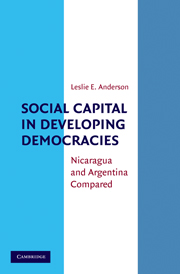Book contents
- Frontmatter
- Contents
- Preface
- 1 An Introduction
- PART I CREATING SOCIAL CAPITAL
- PART II AN EMPIRICAL EXAMINATION OF THE ARGUMENT
- 4 A Tale of Two Neighborhoods: Social Capital in Nicaragua and Argentina
- 5 Democracy and Its Competitors: Political Values in Nicaragua and Argentina
- 6 Participation, Democratic Institutions, and Procedures
- PART III MAKING DEMOCRACY WORK WITHOUT SOCIAL CAPITAL: INSTITUTIONAL CAPITAL
- 8 Conclusion
- Appendix
- Works Cited
- Index
4 - A Tale of Two Neighborhoods: Social Capital in Nicaragua and Argentina
Published online by Cambridge University Press: 05 June 2012
- Frontmatter
- Contents
- Preface
- 1 An Introduction
- PART I CREATING SOCIAL CAPITAL
- PART II AN EMPIRICAL EXAMINATION OF THE ARGUMENT
- 4 A Tale of Two Neighborhoods: Social Capital in Nicaragua and Argentina
- 5 Democracy and Its Competitors: Political Values in Nicaragua and Argentina
- 6 Participation, Democratic Institutions, and Procedures
- PART III MAKING DEMOCRACY WORK WITHOUT SOCIAL CAPITAL: INSTITUTIONAL CAPITAL
- 8 Conclusion
- Appendix
- Works Cited
- Index
Summary
I watched a boy die here. He was lying just out of my reach on this street corner and the gunfire was too thick to go out after him. He kept calling to me. He bled to death. I have never forgotten that.
Sandinista revolutionary Managua, NicaraguaEva Perón gave my mother a sewing machine and that has made everything possible.
Peronist taxi driver Buenos Aires, ArgentinaIt was late June, 1979, in Nicaragua. The southern column of FSLN guerrilla fighters had reached Managua and was engaged in hand-to-hand combat in the streets against Anastasio Somoza's National Guard. It was the beginning of the end, the start of the final battle for control of the capital city and, with it, the country and the state. The guerrillas were being hidden, sheltered, fed, and treated for battle wounds within one southern Managua neighborhood, Bello Horizonte. But in this early stage of the battle for Managua, the guerrillas were losing. The other three columns of guerrilla fighters converging on Managua from the north, west, and east had not yet arrived, so the FSLN leaders of this first column decided to fall back from Managua to the neighboring city of Masaya, less than twenty-five miles away and firmly under the control of the revolutionaries. From there they would wait for the other columns to arrive, and they would converge on Managua together.
- Type
- Chapter
- Information
- Social Capital in Developing DemocraciesNicaragua and Argentina Compared, pp. 115 - 137Publisher: Cambridge University PressPrint publication year: 2010

